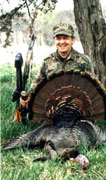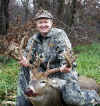Calling Devices
Copyright © 1998 -
2025 Roger
W. Raisch * Nadine Adele, all rights reserved
|
The
evolution of turkey calling devices has proceeded at a tremendous rate in the past 25
years. Primitive wingbone, slate-and-peg and cedar box calls have been modified into
a multitude of different types of calls that utilize modern materials like aluminum,
Plexiglas, and graphite.
Seemingly simple old-time
calls that took a good deal of practice to master have been developed into more complex
but easier to use push-pin types. Even the difficult-to-master gobble can be made
effectively on new tube calls with a minimum of practice.
The commercialization of
the mouth diaphragm has placed a tremendously effective device in the hands of the modern
day turkey hunter.
Single, double, triple, with
or without notches or cuts outs, stacked frame callers, and more have allowed a hunter to
mimic the full range of turkey sounds without having to make any motion.
|
Rather
than describe every caller that is now available, I'll simply discuss the pros and cons of
the various types.
There is a wide
variation in quality of turkey calls. Some cost a lot
and sound terrible. Some sound great and cost little. Some cost a lot and
sound superb. Some custom calls will outperform regular production callers 10 to 1,
but cost no more than "Mass Merchandise" calls. You get the idea.
Be careful when
purchasing calls, even with the relatively inexpensive mouth calls. Many manufacturers do not have good quality control, despite their
high advertising budgets.
|
I
have carefully selected all turkey calls in the Pro's Choice Store based on quality,
sound, reliability, value, and on my personal knowledge of the manufacturer over many
years.
After you make your purchases,
keep turkey calls out of the hands of little children...they are basically musical
instruments and can get permanently ruined by little M & Ms covered hands.
The best way to perfect your
calling is to practice while viewing the Turkey Hunting Secrets
DVD or listen to the Lovett
Williams library both of which contain the various turkey
sounds you need to know with further instruction on turkey calling..
|

Turkey Hunting Secrets
DVD
Super Sale
Price: $3.99
ORDER
|
Turkey
calls are commonly divided into two categories: diaphragm or air-operated calls and friction calls.
|
Friction Calls
|
|
| |
Two of the oldest and most effective types of turkey calls--the Cedar Box Call and Slate Call--are
examples of friction-type calls.
They have probably been used
to bag more turkeys than any other type call because they have been around for many years
and are easy to use.
In newer versions, various
types of woods are used, the slate may be replaced with aluminum, glass, or crystal. The
Striking Pegs (Strikers) may be Plexiglas or Carbon arrow shaft material, rather than
wood.
However, Custom Strikers,
made from various exotic woods, still remain my favorite strikers for producing the
sweetest sounds on all types of slate-type calls.
|
There
are two principal disadvantages to friction calls.
Most require two hands to
operate and many won't work when wet. You can learn to operate some with one hand,
or there are holders available that will strap the call to your leg. But, the
movement problem still exists.
The SECRET to working a friction call effectively is to
set it down immediately after calling and get your weapon ready.
Moisture is another problem
with all wooden calls, including wooden strikers.
Wet wood won't produce good
sounding calls....in fact you'll get no sounds at all if the call is soaked.
New, modern Plexiglas, plastic, and carbon materials have solved the moisture
problem.
Calls or strikers made
from these materials will work when wet. Despite
this, I prefer box calls and strikers made from wood because of their superior sound
qualities.
When hunting in high humidity
or rain, protect a box or slate-type call with a small plastic bag at all times.
Operate it inside the bag.
Friction calls should be considered fine musical instruments.
Keep them in top
condition. Old chalk left on box calls over the summer
will attract moisture and harden.
Lightly sand the lid or
striker before using it and apply new chalk to restore its former sweet tones.
Always use carpenter's chalk, not black-board chalk. Or use the chalk that comes
with the call. Keep slate-type calls in a Friction Call Case to
protect them from scratches, abrasion, dirt, grim, moisture and pesky little
hands.
|
Despite
the movement and moisture problems, cedar box calls and slate-type calls and their new
counterparts, made with modern materials, produce some of the most realistic turkey calls
you'll find, beating out even the versatile mouth call.
I never go to the woods
without at least one slate and one box call. I pull out a slate-type call and start
every morning's hunt with the sweet, low-volume half-yelping sounds of a Tree Call.
|
Diaphragm
Calls
|
Diaphragm
mouth calls have revolutionized turkey hunting by making it possible to reproduce nearly
any turkey sound without having to move your hands.
This makes them excellent
calls particularly for close-in work. The obvious drawback is that they take
considerably more practice to master.
Most Master Turkey Hunters have learned to use a
mouth call out of necessity.
Learning to use a mouth call
can be quite simple if you follow the System
I have developed. There are many styles and sizes of mouth calls so that any
hunter can find one that is suitable and comfortable. Diaphragms take most hunters
about two to three months to master, but the sacrifice is well worth the effort.
|
The
principal differences in mouth calls are based on the thickness of the latex reeds, number
of reeds, their spacing, and the type and number of "cuts" or
"notches" in them.
Thicker reeds produce deeper,
louder tones, and are the hardest to learn to blow because they require more air and
tongue control. They are harder to control at low volumes also.
Raspy tones are introduced by
notching the leading edge of the reeds at the sides or in the middle. Twin or triple
reed calls produce coarser and raspier sounds, particularly those that have
"stacked" frames (two or more frames).
Beginners should probably
start with a thin, single reed call, move up to a double reed call and finally to a triple
reed call as they gain more confidence and control.
A Perfection Selection is
a great collection of calls to use to develop proper air and tongue control and they make
all the sounds necessary to bag a gobbler.
|
Most serious hunters have several mouth calls already broken in, so they
are prepared for any calling situation.
Further, they keep their
calls in a Mouth Call Saver
which protects, preserves and keeps them tuned and lubricated--ready to use. With proper care, a high-quality mouth
call will last for several years and continue to sound good.
In the off-season, rinse your
mouth calls with clean water, place flat toothpicks between the reeds to separate them and
store them in the refrigerator.
Single-reed calls are
excellent for making soft smooth tree yelps and pits.
Double reed calls produce good
plain yelps and clucks.
Triple reeds and calls with
heavy double, triple, or quad reeds make good cackles, loud yelps, cutts, and assembly
yelps for long-distance calling or for windy conditions.
If I could have just one mouth
call to fit all situations, it would be a medium-weight, notched double or triple reed
call.
|
Other Air-Operated Callers
|
 $39.99 ORDER $39.99 ORDER
Three-Piece Fancy
Wingbone Call
|
Many
other types of air-operated diaphragm callers have been developed from such diverse items
as film canisters, snuff tins and pill bottles, coupled with the appropriate reed
mechanism.
Commercial models are also
available. These make very realistic turkey sounds and are particularly good for
gobbling. Most require the use of at least one hand to operate, requiring movement.
|
Final
Thoughts
|
Turkey
voices range from smooth and silky to coarse and raspy, so the tone you select is not
critical.
You should settle on
calls you like, that sound realistic and you can operate consistently.
One of the SECRETS to turkey calling is confidence, knowing the
call you want to make will come out correctly every time when you operate your caller.
Make sure you choose a type of
call and model that you can make great turkey sounds with. Don't worry about the
tone and pitch of the caller you choose, as long as the rhythm is correct.
Even though you may not feel
confident with a mouth call, all is not lost. Many turkeys are bagged routinely with
friction calls...just remember to not move when a turkey can see you operate the
call.
|
Regardless
of which call is my current favorite, I carry a wide variety of locator, friction, and
mouth calls with me to the woods.
Sometimes it takes a
particular sound to stimulate a turkey to gobble, or to entice him to come over to check
me out.
I try different calls until I
find the one he likes. |
| |
|
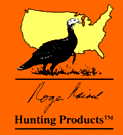
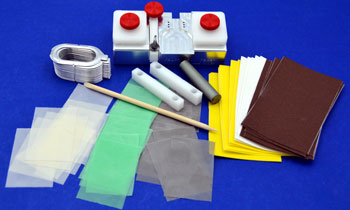

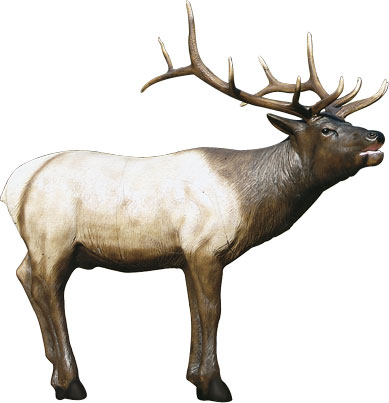

 $39.99
$39.99 
